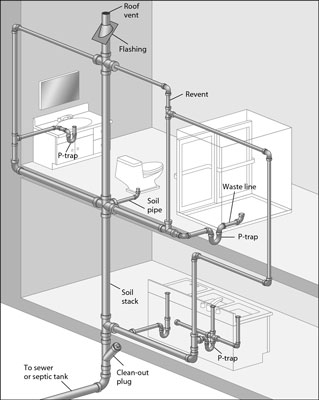Waste Stack Repair & Replacement
Waste Stack Repair & Replacement in St. Louis
Keep Your Home Safe with Proper Waste Stack Services
A waste stack, also known as a drain-waste-vent (DWV) system, is a crucial part of your home’s plumbing. This large-diameter vertical pipe carries wastewater from toilets, sinks, and other drains to the sewer line, while venting sewer gases safely through the roof. If your plumbing stack is not draining or venting properly, your home could be exposed to dangerous waste materials and noxious gases.
In a typical home, there are usually one or two waste pipes, while multi-unit buildings may have several.
Call (314) 487-4564 today to schedule a waste pipe repair or inspection.

Common Waste Stack Problems & Warning Signs
Foul Odors or Gurgling Sounds
Blocked or damaged roof vents can prevent proper venting, causing noxious sewer gas buildup in your home. This is often seen in newly finished basements where plumbing fixtures aren’t correctly connected to the stack. Solutions may include:
-
Installing a vent cover to prevent birds or debris
-
Replacing damaged vent sections
Clogs and Blockages
Waste buildup can lead to seriously backed-up drains and tubs. Small clogs may be accessed via the clean-out plug, but deeper blockages require professional inspection using cameras and advanced techniques like hydro-jetting or commercial drain snakes.
Cracks or Ruptures
If you notice water damage near the waste pipe along with strong odors, your pipe may be cracked or ruptured. Immediate action is critical:
-
Turn off the water to the home
-
Call a licensed plumbing professional
Older homes with clay or cast-iron stacks are especially prone to wear and may require full replacement.
Waste Stack Repair or Replacement
Repair Waste Stack
For newer PVC plumbing stacks, small cracks or leaks can often be patched safely.
Replace Waste Stack
Major damage, older cast-iron pipes, or systems beyond their lifespan should be replaced immediately. Modern PVC plumbing stacks offer improved durability and compatibility with today’s plumbing and HVAC systems.
Cast-iron pipes may fail in as little as 20 years and cannot handle the pH levels from high-efficiency HVAC condensate, making replacement the safest option.
Why Choose Bieg Plumbing for Waste Stack Services
-
Experienced Professionals – Over 60 years of serving the St. Louis community
-
Full-Service DWV Solutions – Unclog, repair, or replace waste pipes efficiently
-
Licensed & Equipped – Modern tools and inspection cameras for accurate diagnosis
-
Emergency Service Available – Fast response when you need it most
⚠️ Don’t wait until a minor issue becomes a major problem. Contact Bieg Plumbing & Mechanical today at (314) 487-4564 for expert waste pipe inspection, repair, or replacement.

